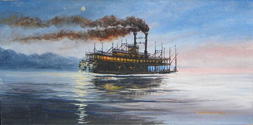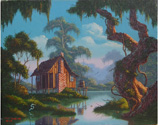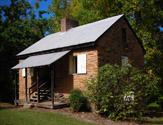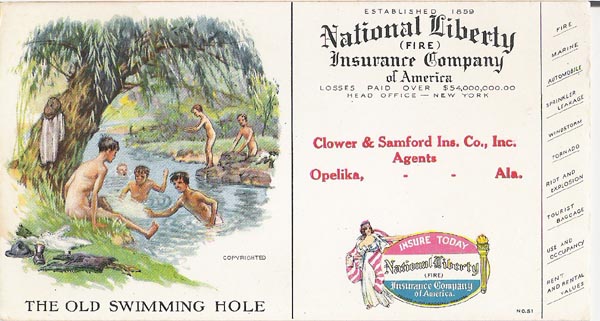















Cotton States Archive
Ink Blotter:
"The Old Swimmin' Hole"
"The Old Swimmin' Hole"
Talk to anyone who was raised in the rural South during hard times, and it doesn't take long to figure out that kids had to use their imaginations and employ a little creativity to have fun or find entertainment. Fancy toys and gadgets of modern times were non-existent, and struggling parents couldn't afford to buy non-essentials in the first place. Besides, children were an integral part of every farm, and allotting time for play was not a priority. Cotton had to be picked, vegetables needed harvesting, daily, mundane chores (like milking, gathering eggs and drawing water) couldn't be forgotten and time had to be made for church and school. By bedtime each night, sleep was a welcomed friend.
Today's idle and lethargic generation, with every imaginable bell and whistle at their beckoning call, can't begin to imagine the delight kids in previous eras must have experienced when a free afternoon or evening allowed them to play even the simplest of games or go on mini adventures.
Girls cut out paper dolls, jumped rope and played "hide and seek" or hopscotch. Boys played "cowboys and Indians," fished with cane poles, made slingshots and journeyed to their favorite, secluded spot along some nearby stream where an au naturel swim was generally in order. The company of good friends and a nice, sturdy swinging vine made for an exciting time.
James Whitcomb Riley (1849-1916), widely hailed as the "Hoosier Poet," published his notable work The Old Swimmin' Hole in the late 1800s, but the affinity for a dip in the creek on a hot, summer afternoon wasn't just shared among energetic, rambunctious Indiana farm boys. Perhaps evoking fond memories for some while eliciting a chuckle from others, scenes (like the one depicted on the accompanying ink blotter) of boys frolicking in their favorite swimmin' hole were once replicated in many a southern stream, river, pond and bayou. Obviously, swimsuit designers had not yet come into their own!
Today's idle and lethargic generation, with every imaginable bell and whistle at their beckoning call, can't begin to imagine the delight kids in previous eras must have experienced when a free afternoon or evening allowed them to play even the simplest of games or go on mini adventures.
Girls cut out paper dolls, jumped rope and played "hide and seek" or hopscotch. Boys played "cowboys and Indians," fished with cane poles, made slingshots and journeyed to their favorite, secluded spot along some nearby stream where an au naturel swim was generally in order. The company of good friends and a nice, sturdy swinging vine made for an exciting time.
James Whitcomb Riley (1849-1916), widely hailed as the "Hoosier Poet," published his notable work The Old Swimmin' Hole in the late 1800s, but the affinity for a dip in the creek on a hot, summer afternoon wasn't just shared among energetic, rambunctious Indiana farm boys. Perhaps evoking fond memories for some while eliciting a chuckle from others, scenes (like the one depicted on the accompanying ink blotter) of boys frolicking in their favorite swimmin' hole were once replicated in many a southern stream, river, pond and bayou. Obviously, swimsuit designers had not yet come into their own!

Appearing to be a post card at first glance, this advertising item is actually an unused ink blotter. The reverse is covered with a felt-like material.
BIBLIOGRAPHY
"James Whitcomb Riley (1849-1916)," World Book Encyclopedia, Volume 16. (Chicago: Field Enterprises Educational Corporation, 1968).
"James Whitcomb Riley (1849-1916)," World Book Encyclopedia, Volume 16. (Chicago: Field Enterprises Educational Corporation, 1968).
Author: Greg Freeman. Published May 21, 2006.
Copyright
Southern Edition
All Rights Reserved
Southern Edition
All Rights Reserved
All materials contained on this site, including text and images, are protected by copyright laws and may not be reproduced without prior written permission from the publisher. Where applicable, use of some items contained on this site may require permission from other copyright owners.
Fair Use of text from SouthernEdition.com is permitted to the extent allowed by copyright law. Proper citation is requested. Please use this guide when citing a Southern Edition article.
Contact Greg Freeman or SouthernEdition.comFair Use of text from SouthernEdition.com is permitted to the extent allowed by copyright law. Proper citation is requested. Please use this guide when citing a Southern Edition article.